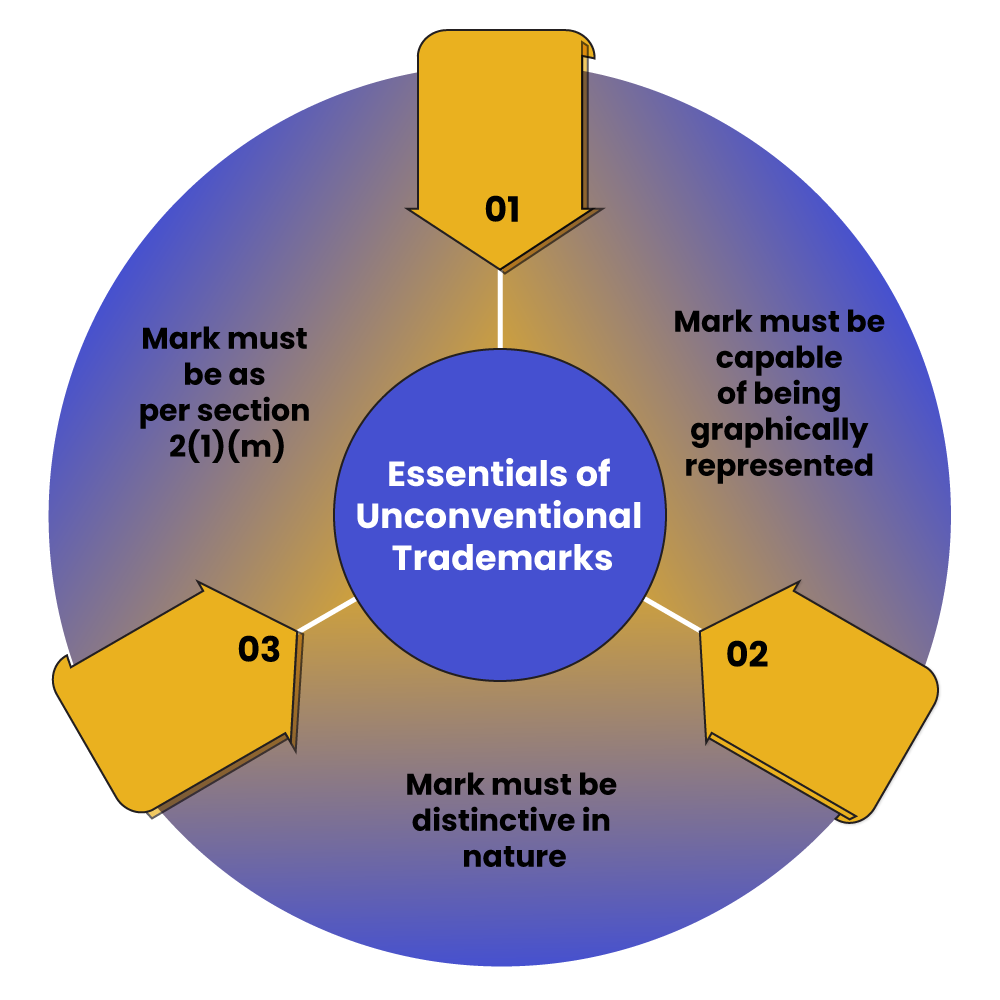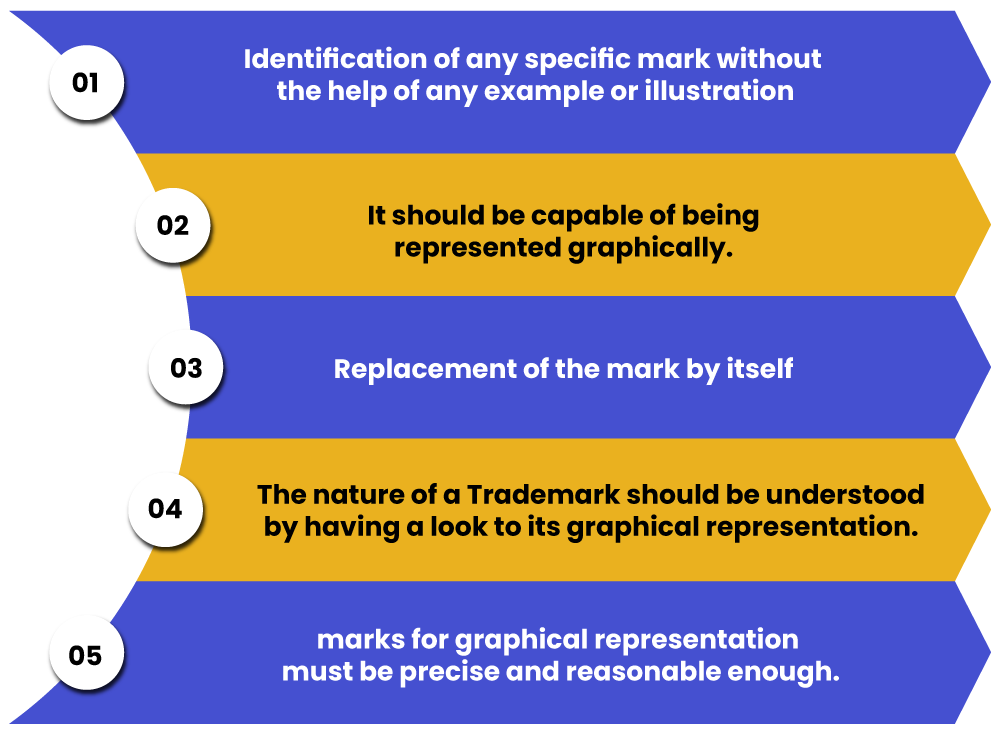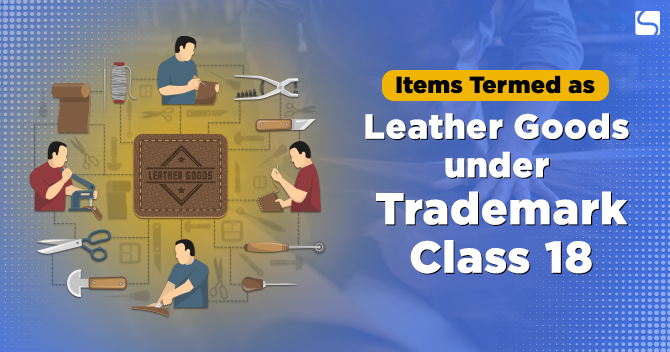Unconventional Trademarks in India- Concept and Position

Sanchita Choudhary | Updated: Nov 24, 2020 | Category: Trademark
A trademark has been defined under Section 2(1) (zb) of the Trademarks Act. As per this section “such marks which are capable of being represented graphically as well as of distinguishing the goods or services of one owner from those of others and this also includes the shape of goods along with their packaging and combination of colours.”
In case of any mark, either it is a word or device, brands, headings, letter, numbers if capable of distinguishing goods and services of one person from that of another, can be registered as a trademark in India. In this blog, we will discuss the complete concept of Unconventional Trademarks in India.
Table of Contents
The need of Legal Protection
In order to establish fair trade and practise and competition in the market, it is necessary to have legal protection for the owner of the Trademark. However, in the absence of such appropriate legal protections, consumers can easily be deceived or confused and cheated. On the other hand, the manufacturer will not only suffer financial but also reputational loss.
Moreover, for protection of Industrial Property 1883[1], a convention was passed namely Paris Convention which specifically dealt with industrial property in the widest sense thus covering the various aspects of Trademarks as well.
Unconventional Trademark in India
An unconventional Trademark in India is defined as nothing but Trademark of items other than those of goods or brand’s name. These unconventional Trademarks majorly include sounds, colours, factory mark, and motion mark and so on. As stated under the definition of Trademark it is necessary that each trademark registered must be different from each other. Thus, it can be stated that unconventional trademarks also form a part of regular trademarks only.
Any regular trademark can be easily registered using its distinct features either by design or by alphabet but the same process of registration is not easy for the graphical representation. These are categorised to be unconventional Trademark.
Essentials for Unconventional Trademark in India

In order to get protection under the Trademark Act, 1999 following are some of the essential in relation to unconventional Trademarks in India:
- The mark should be a “mark” as defined under the Section 2(1) (m) and should include any device, brand, label, headings, logos, symbols, numbers, shapes, letters, colour combinations and so on,
- The mark must be capable of being graphically represented,
- The Trademark must be distinctive in nature.
The Trademark can also be a class dependent mark which can be acquired wholly or in form of one or more specified colours then in such conditions, the combination of these colours must e different from each other thus making the specified Trademark distinctive in nature.
Amendments Made in Unconventional Trademark
The amendments or developments in the area of unconventional Trademarks must be credited to Trade Related Aspects to Intellectual Property Rights (TRIPS) agreement. TRIPS agreement is a form of the international convention based on the Intellectual Properties which helps in setting the legal standing in this regard.
TRIPS agreement includes a trademark such as colour trademarks, shape trademarks, trademarks in relation to holograms and many more. India is a signatory to both the agreements namely TRIPS agreement and Paris agreement thus is under the obligation to follow the guidelines set by these conventions.
However, it can further be stated that the trademark may consist of any sign which is not in itself capable of being perceived visually, provided that it can be represented graphically, particularly by means of images, lines or characters, and that the representation is clear, precise, self-contained, easily accessible, intelligible, durable and objective.
Legal Provisions Relating to Unconventional Trademarks in India

There are various laws relating to Trademark in India. In India, these laws have developed with a very high pace since last 10 years primarily because of the changes brought in the following regulations:
- International conventions,
- TRIPS Agreement
- Introduction of Trademark Rules 2017
- Section 2(1) (zb) and 2(1)(m) of Indian Trademark Act,1999
- Rule 26 and 2(k) of Trademark Rules 2002.
Graphical Representation- An Overview

In order to get a Trademark registered it is required for that trademark to be graphically represented as mentioned in the Trademark Act, 1999. The term ‘graphically represented means that any such specific Trademark which is capable of either being published in the journal or register in physical form. Graphical representation shows the fixed point of reference thus indicating what the mark actually is about.
Criteria to Be Fulfilled In Order To Graphically Represent a Trademark
Any specific mark can be graphically represented if it fulfils following criteria’s
- If it is possible to identify any specific mark without the help of any example or illustration, then such mark can be represented graphically.
- It should be capable of being represented graphically.
- A graphical representation can even replace the mark by itself
- Anyone either going through the trademark journal or inspecting such Trademark journals are able to understand the nature of a Trademark by having a look to its graphical representation.
- Thus it is considered to be important that while submitting any marks for graphical representation such mark must be precise and reasonable enough. These marks include musical notation, colour standards or even the scientific measurements.
Also, Read: Know the Procedure to Apply for Trademark Registration
Types of Unconventional Trademarks in India
There are various types of marks which lack the capacity to be graphically represented in India. Some of these marks thus come under the ambit of Unconventional Trademarks. Therefore following are some of the marks which are considered under the category of an unconventional trademark in India:
- Sound Marks
- Smell Mark
- Mark of a Hologram
- Tastes
- Varieties of Shapes
- Motion
- Marks related to Textures
Sound Marks
- The sound marks can be graphically represented either by the musical notations or with the help of written descriptions.
- However, it was held by the ECJ that the basic requirement of graphical representation was not satisfied in case if the sound was represented graphically by using written language.
- Graphical representation of a mark of sound is said to be accepted only if a sound is divided into measures such as musical notes etc.
- Further, it has also been stated about the mark of sound that if the mark is described in the form of musical notes then such marks must be filed with the Trademark registry.
Smell Marks
- The smell marks are tough to be registered as a Trademark in India as it is considered to be a source identifier.
- The problem with smell marks to be registered is a visual representation of the same along with the storage. However, there are instances of smell marks that are registered in the world.
- Illustration: Bubblegum Smell for sandals has been registered under Trademark registration in India.
- Any specific trademark can be registered in India if the graphical representation of such a specific mark is self-contained, durable, intelligible and easily accessible.
Hologram Marks
- A hologram is defined as a cross between any photograph and reality.
- A hologram records the scattered light and looks that light moving.
- Any mark for hologram is considered to be difficult to register under Trademark registration.
Taste Mark
- Taste marks are treated similar to the mark of smell. However, it was declared that the tastes marks can be represented and registered under the Trademark Act, 1999.
- Further, it was stated that for a taste mar to be registered in India there are certain standards and guidelines which must be fulfilled.
- The recognition of the taste mark is deemed to be difficult rather different from the registration of other unconventional Trademarks available in India.
Shapes
- Shapes are deemed to be the appearances which are distinctive in nature. These shapes include all kinds of labels or containers used for packaging, wrapping etc.
- The shape of any product is considered under Trademark only if that specific shape is distinctive in nature and has not been used earlier.
- Shapes mark has been recognised by India under the Trademarks Act, 1999.
Position of Unconventional Trademarks in India
- The Trademark Act, 1999 which Indian follows is influenced by the laws of the United States as well as that of the United Kingdom. Both in India and in the UK, the graphical representation is considered to be necessary for the registration of Trademark. Hence, the doctrine of functionality is also important both in India as well as in the United States.
- As per the new Trademark Rules, 2017 the sound marks can be registered as Trademark as per the Rule 26(5). This can be done by submitting the sound clip with the musical notations which should not exceed more than thirty seconds.
- Further, the colour marks can also be submitted by producing a combination of colours. In this case, the onus to prove the distinctive nature or characteristics of both sound and colour lies on the applicant.
- As per Section 18 of the Trademarks Act, 1999 the registration of a Trademark should be done in accordance with the Trademark Rule.
- As stated under Rule 25(12) (b) of 2002 the registration of Trademark should be in such a manner so that it can be graphically represented.
- Rule 28 of the Trademarks Act, states that the Trademarks must be represented on the paper.
- Rule 29(3) of the Trademarks Act, further states that the three-dimensional trademark can also be registered.
- Moreover, Rule 30 states that any specification made to the graphical representation must be satisfactory as well as durable.
- It can further be stated that Section 9(3) of the act further mentions about the exception on the registration of shapes derived from the technical results or nature of the goods which adds some substantial value of the product.
Case Law Regarding the Position of Unconventional Trademark in India
1.William Grant & Sons Ltd. versus Mc Dowell Co. Ltd.
The Indian Courts for the first time, in this case, discussed about the trade dress. It was held in this case that in regards to shapes, the trade dress must be distinct in character as well as they must have secondary significance. The court also further held that the single colours cannot be inherently distinctive. Further, the visual perceptibility is not considered as criteria under the Indian Trademark Laws.
2. Shield Mark BV versus Joost Kist
In this case, India adopted the doctrine of shield mark while granting registration for the sound mark. The ECJ, in this case, held that the written format of sound lacked precision along with the clarity and therefore it would not be considered under graphical representation. The court also stated further that sound in itself is distinctive in nature and thus can be easily recognized by simply hearing it.
Thus it can clearly be understood, that India still needs to recognise and realise the potential of smell as well as taste marks along with the problems associated with the graphical representation of the same and thus must find a way to resolve such issues.
Conclusion
Thus, it can be clearly stated that there are two types of Trademarks. One is a conventional trademark and the other one is an unconventional trademark. Both of these Trademarks are distinctive in nature and thus fulfil the essence of being represented graphically. However, in respect of laws regarding the unconventional Trademarks, India has adopted more of the US view rather than the UK. Moreover, India still needs to develop a kind of strict enactment in relation to the unconventional trademarks through various precedents and amendments. Thus, as per the laws regarding Trademark as well as the graphical representation, any unconventional Trademark may not become noteworthy in the commercial market.
Also, Read: What are the Steps in the Legal Process of Trademark Registration?














